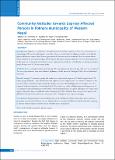Please use this identifier to cite or link to this item:
https://hdl.handle.net/20.500.14356/1878Full metadata record
| DC Field | Value | Language |
|---|---|---|
| dc.contributor.author | Adhikari, B | - |
| dc.contributor.author | Shrestha, K | - |
| dc.contributor.author | Kaehler, N | - |
| dc.contributor.author | Raut, S | - |
| dc.contributor.author | Chapman, S R | - |
| dc.date.accessioned | 2023-05-30T05:24:03Z | - |
| dc.date.available | 2023-05-30T05:24:03Z | - |
| dc.date.issued | 2013 | - |
| dc.identifier.citation | AdhikariB., ShresthaK., KaehlerN., RautS., & ChapmanS. R. (2014). Community Attitudes towards Leprosy Affected Persons in Pokhara Municipality of Western Nepal. Journal of Nepal Health Research Council. https://doi.org/10.33314/jnhrc.v0i0.402 | en_US |
| dc.identifier.issn | Print ISSN: 1727-5482; Online ISSN: 1999-6217 | - |
| dc.identifier.uri | http://103.69.126.140:8080/handle/20.500.14356/1878 | - |
| dc.description | Original Article | en_US |
| dc.description.abstract | Abstract Background: Stigma is a social process of interpretation of an attribute. Leprosy has been seen as the epitome of stigmatization. The psychosocial impact a person has to bear in a society after the diagnosis weighs heavier than the physical afflictions it causes, which does not get cured with the mere medical treatment. There are various factors which construct the perception of stigma in both leprosy affected persons and unaffected persons. The main purpose of this study was to determine the level of perceived stigma and the risk factors contributing to it among community people living in ward 15, Pokhara municipality. Methods: Cross-sectional descriptive study among 281 community people above the age of 18 years was conducted. Two sets of questionnaire form with additional Explanatory Model Interview Catalogue (EMIC) for each individual were used. Results: Among 281 community people, the median score of perceived stigma was 12 while it ranged from 0-30. Ethnic groups, Brahmins, Dalits and minorities had highest perceived stigma score of 15 and above compared to the rest (p=0.001), community people living at the distance more than 2 km had highest perceived stigma score of 15 compared to those living closer to the hospital (p=0.019) and nuclear family had highest perceived stigma score of 15 compared to the joint family (p=0.014). People who lacked information on leprosy had higher score of perceived stigma compared to those who had information on leprosy (p=0.002).Similarly, those who perceived leprosy to be difficult to treat (p<0.001) and a severe disease (p<0.001) had highest score of perceived stigma. Conclusions: Stigma in leprosy was found highly associated with the lack of information about leprosy and their perception in treatment and disease severity. Stigma reduction strategies should focus on health education, targeting to alleviate their perception about the disease with their active participation. Keywords: attitude; community; leprosy; stigma. | en_US |
| dc.language.iso | en | en_US |
| dc.publisher | Nepal Health Research Council | en_US |
| dc.relation.ispartofseries | Sep-Dec, 2013;402 | - |
| dc.subject | Attitude | en_US |
| dc.subject | Community | en_US |
| dc.subject | Leprosy | en_US |
| dc.subject | Stigma | en_US |
| dc.title | Community Attitudes towards Leprosy Affected Persons in Pokhara Municipality of Western Nepal | en_US |
| dc.type | Journal Article | en_US |
| local.journal.category | Original Article | - |
| Appears in Collections: | Vol. 11 No. 3 Issue 25 Sep - Dec, 2013 | |
Files in This Item:
| File | Description | Size | Format | |
|---|---|---|---|---|
| 402-Article Text-496-1-10-20140309.pdf | Fulltext Download | 638.07 kB | Adobe PDF |  View/Open |
Items in DSpace are protected by copyright, with all rights reserved, unless otherwise indicated.
